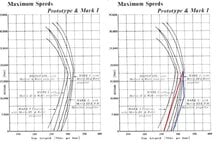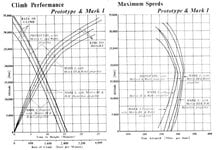There has been some recent discussion on this so I am posting some relevant info. From the Hurricane table, which does not include boost level, the Trop Hurricane I loses about 30 mph and the Trop Hurricane IIa loses about 7 mph. I can tell from the numbers that the Hurricane I is using 12lbs boost but it is unclear what the Trop Hurricane I is using. My guess is 6 or 7lbs as 312 mph is often used for a Tropoical MK I. Both Hurri IIa's appear to be using 12lbs in low gear. The Huricane IIb in the table is using only 9 Lbs boost as that full report is available.
Navigation
Install the app
How to install the app on iOS
Follow along with the video below to see how to install our site as a web app on your home screen.
Note: This feature may not be available in some browsers.
More options
You are using an out of date browser. It may not display this or other websites correctly.
You should upgrade or use an alternative browser.
You should upgrade or use an alternative browser.
Tropical performance of Hurricane and Spitfire
- Thread starter slaterat
- Start date
Ad: This forum contains affiliate links to products on Amazon and eBay. More information in Terms and rules
More options
Who Replied?ThomasP
Senior Master Sergeant
All of the Mk Is in the above charts are using 3000 rpm at +6.25 lb boost at ~16,250 ft (no RAM) or ~17,500 ft (with RAM)
All of the Mk IIs are using 3000 rpm at +9 lbs at ~11,800/18,250 ft in low/high gear respectively (no RAM), or 12,500-13,000 ft in low gear (with RAM) and 20,000-22,000 ft in high geart (with RAM).
NOTE that the altitudes for the Hurricane Mk II max speeds listed in the Hurricane Performance Summary are incorrect. The 340 mph for the Mk IIA (clean) was achieved at 22,000 ft during testing, while the 328 mph for the Mk IIC (clean) was achieved at 20,800 ft.
FWIW the Spitfire Mk VC in the RAAF report was using a Merlin 46 engine so the maximum speeds are occurring about 2,000 ft higher than they would be with the Merlin 45. Spit Mk Vs with the Merlin 45 achieved their top speeds at 19,000- 20,000 ft when using 3000 rpm at +9 lbs boost (with RAM).
PS I am pretty sure that the RAAF Spitfire Mk VC performance numbers are for a standard Mk VC with Merlin 46, and not one fitted with the tropical filter - but I cannot say for sure.
All of the Mk IIs are using 3000 rpm at +9 lbs at ~11,800/18,250 ft in low/high gear respectively (no RAM), or 12,500-13,000 ft in low gear (with RAM) and 20,000-22,000 ft in high geart (with RAM).
NOTE that the altitudes for the Hurricane Mk II max speeds listed in the Hurricane Performance Summary are incorrect. The 340 mph for the Mk IIA (clean) was achieved at 22,000 ft during testing, while the 328 mph for the Mk IIC (clean) was achieved at 20,800 ft.
FWIW the Spitfire Mk VC in the RAAF report was using a Merlin 46 engine so the maximum speeds are occurring about 2,000 ft higher than they would be with the Merlin 45. Spit Mk Vs with the Merlin 45 achieved their top speeds at 19,000- 20,000 ft when using 3000 rpm at +9 lbs boost (with RAM).
PS I am pretty sure that the RAAF Spitfire Mk VC performance numbers are for a standard Mk VC with Merlin 46, and not one fitted with the tropical filter - but I cannot say for sure.
Last edited:
Shortround6
Major General
I would also note that the Merlin 46 gave around 80-100hp less than a Merlin 45 at lower altitudes (lower than the FTH of Merlin 45). As in 85hp less at 12lbs boost for take-off.
Hanging the tropical filter on it and then flying at low level was a double whammy. All (?) of the mock dogfights in the RAAF evaluation were done at heights below the FTH (full throttle height) of the Merlin 46.
Hanging the tropical filter on it and then flying at low level was a double whammy. All (?) of the mock dogfights in the RAAF evaluation were done at heights below the FTH (full throttle height) of the Merlin 46.
- Thread starter
- #4
All of the Mk Is in the above charts are using 3000 rpm at +6.25 lb boost at ~16,250 ft (no RAM) or ~17,500 ft (with RAM)
Hurricane I tests would appear to disagree with that.
- Thread starter
- #5
At first, I was thinking the same, but at the very top of the report it does state that it is a Tropical Spit VPS I am pretty sure that the RAAF Spitfire Mk VC performance numbers are for a standard Mk VC with Merlin 46, and not one fitted with the tropical filter - but I cannot say for sure.
How do you figure?Hurricane I tests would appear to disagree with that.
- Thread starter
- #7
All of the Mk IIs are using 3000 rpm at +9 lbs at ~11,800/18,250 ft in low/high gear respectively (no RAM), or 12,500-13,000 ft in low gear (with RAM) and 20,000-22,000 ft in high geart (with RAM).
Do you have the full reports on the IIa's ? I have not found one of them anywhere on the internet.
I was basing my thoughts on reports like these as they do include boost levels.
I appreciate your interest and input
- Thread starter
- #8
because the graph shows the rotol equipped Hurricane I doing 265mph at 6.25 lbs, sea level, and 12lbs boost for 285 at sea level.How do you figure?
- Thread starter
- #9
It does seem odd as most of the intercepts were at 20 k or above. I have just received my copy of "The Darwin Spitfires" (waited patiently for years) so am currently reading it, so far very interesting.Hanging the tropical filter on it and then flying at low level was a double whammy. All (?) of the mock dogfights in the RAAF evaluation were done at heights below the FTH (full throttle height) of the Merlin 46
because the graph shows the rotol equipped Hurricane I doing 265mph at 6.25 lbs, sea level, and 12lbs boost for 285 at sea level.
If any of the curves in the jpeg picture/graph you've posted were actually achieved with over-boost, the best speed would've been achieved at ~10000 ft, not at around 17000-18000 ft. My conclusion is that the graph you've kindly pprovided is misleading in the way that it adds ever greater amount of speed from the rated altitude towards the SL, finishing there at some extra 20 mph than what was historically the case.
The speed graphs posted there would've been possible if the Merlin III was with the variable speed S/C?
To illustrate the point, I've added the red line for what is my understanding how the speed should've been between the SL and ~18000 ft on 87 oct fuel, and the blue line for the usage of 100 octane, while to the left side is the original graph unaltered - all for the Hurri I with Merlin III and DH prop.

RAAF tests of various intake designs on Spit V/Merlin 46 using 16lb boost:
from Australian Archives:
Title
DTS [Directorate Technical Services] - Spitfire Aircraft - Performance comparison - tropical and non-tropical types
Contents date range
1942 - 1944
Series number
A705
BWOC here's the RAE chart for Spitfire V/Merlin 45 speed with 16lb boost pencilled in:
http://www.wwiiaircraftperformance.org/Spitfire_V_Level_Speed_RAE.jpg
To RAAF HQRS
From OHQ RAAF KWAY
6 Sept 1943
Spitfire Aircraft Engineering.
5 Spitfire Mk 5 aircraft given extensive test fights here successively with each of the following types of of air intake assembly and engine cowling. (A) original tropical (B) New Tropical with bypass valves (C) Temperate.
Average max speeds were
1 sea level) A) 312 B) 312) C) 316
2 10000ft) A) 355.5 B) 355.5 C) 360
3 at FTH ) A) 357 B) 358.5 C) 363
Considered that improvements in speed were too small to warrant departure from original type tropicalization hence new scheme will not be applied retrospectively to Mk5 aircraft. Latest tropical intake with bypass valve will be incorporated Mk 8 aircraft.
from Australian Archives:
Title
DTS [Directorate Technical Services] - Spitfire Aircraft - Performance comparison - tropical and non-tropical types
Contents date range
1942 - 1944
Series number
A705
BWOC here's the RAE chart for Spitfire V/Merlin 45 speed with 16lb boost pencilled in:
http://www.wwiiaircraftperformance.org/Spitfire_V_Level_Speed_RAE.jpg
- Thread starter
- #12
To illustrate the point, I've added the red line for what is my understanding how the speed should've been between the SL and ~18000 ft on 87 oct fuel, and the blue line for the usage of 100 octane, while to the left side is the original graph unaltered - all for the Hurri I with Merlin III and DH prop
The chart you added to does not show boost levels used for the results, much like the table I posted.
Look at these reports
Hurricane L-2026 Trials Report at 6.25 lbs boost
87 oct fuel = max boost of +6.25 between SL and the rated altitude (~18000 ft with ram).The chart you added to does not show boost levels used for the results, much like the table I posted.
100 oct = max boost of +12 psi between SL and ~10000 ft (with ram).
- Thread starter
- #14
From the Hurricane @ manual, it gives the weight increase for the air filter on the Hurricane II, as " mod # 264 +28.92 lbs". Over all it was a fairly tidy installation that cost the Hurricane about 7 mph due to increased drag and reduced ram.
The affect on the Spit 5 is a bit more, as the nose cowling was enlarged for a larger oil tank, to help with cooling. The increased temperatures in the tropics were harder on the spit than the Hurricane as the spits wing mounted rads received very little air flow when on the ground. The Hurricanes center mounted rad got some air flow from the prop.
This from the wayback machine, https://web.archive.org/web/2016022...dex.php?page=the-vokes-air-filter-controversy
The affect on the Spit 5 is a bit more, as the nose cowling was enlarged for a larger oil tank, to help with cooling. The increased temperatures in the tropics were harder on the spit than the Hurricane as the spits wing mounted rads received very little air flow when on the ground. The Hurricanes center mounted rad got some air flow from the prop.
This from the wayback machine, https://web.archive.org/web/2016022...dex.php?page=the-vokes-air-filter-controversy
Fatboy Coxy
Airman 1st Class
- 129
- Aug 24, 2019
From the Hurricane @ manual, it gives the weight increase for the air filter on the Hurricane II, as " mod # 264 +28.92 lbs". Over all it was a fairly tidy installation that cost the Hurricane about 7 mph due to increased drag and reduced ram.
The affect on the Spit 5 is a bit more, as the nose cowling was enlarged for a larger oil tank, to help with cooling. The increased temperatures in the tropics were harder on the spit than the Hurricane as the spits wing mounted rads received very little air flow when on the ground. The Hurricanes center mounted rad got some air flow from the prop.
This from the wayback machine, https://web.archive.org/web/2016022...dex.php?page=the-vokes-air-filter-controversy
Hi slaterat, thank you for the link, a most interesting article, the Vokes air filter does get a 'bad press'
Users who are viewing this thread
Total: 1 (members: 0, guests: 1)

